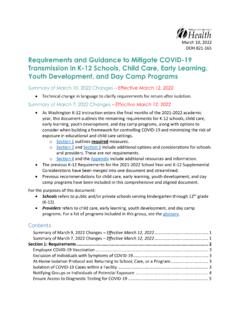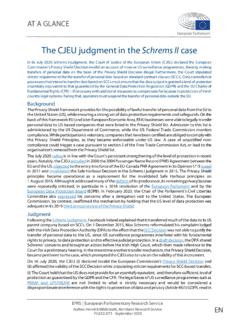Transcription of Data Protection Law: An Overview - Federation of American ...
1 data Protection Law: An Overview March 25, 2019 Congressional Research Service R45631 Congressional Research Service SUMMARY data Protection Law: An Overview Recent high-profile data breaches and other concerns about how third parties protect the privacy of individuals in the digital age have raised national concerns over legal protections of Americans electronic data . Intentional intrusions into government and private computer networks and inadequate corporate privacy and cybersecurity practices have exposed the personal information of millions of Americans to unwanted recipients. At the same time, internet connectivity has increased and varied in form in recent years. Americans now transmit their personal data on the internet at an exponentially higher rate than in the past, and their data are collected, cultivated, and maintained by a growing number of both consumer facing and behind the scenes actors such as data brokers.
2 As a consequence, the privacy , cybersecurity and Protection of personal data have emerged as a major issue for congressional consideration. Despite the rise in interest in data Protection , the legislative paradigms governing cybersecurity and data privacy are complex and technical, and lack uniformity at the federal level. The constitutional right to privacy developed over the course of the 20th century, but this right generally guards only against government intrusions and does little to shield the average internet user from private actors. At the federal statutory level, there are a number of statutes that protect individuals personal data or concern cybersecurity, including the Gramm-Leach-Bliley Act, Health Insurance Portability and Accountability Act, Children s Online privacy Protection Act, and others.
3 And a number of different agencies, including the Federal Trade Commission (FTC), the Consumer Finance Protection Bureau (CFPB), and the Department of Health and Human Services (HHS), enforce these laws. But these statutes primarily regulate certain industries and subcategories of data . The FTC fills in some of the statutory gaps by enforcing a broad prohibition against unfair and deceptive data Protection practices. But no single federal law comprehensively regulates the collection and use of consumers personal data . Seeking a more fulsome data Protection system, some governments such as California and the European Union (EU) have recently enacted privacy laws regulating nearly all forms of personal data within their jurisdictional reach. Some argue that Congress should consider creating similar protections in federal law, but others have criticized the EU and California approaches as being overly prescriptive and burdensome.
4 Should the 116th Congress consider a comprehensive federal data Protection law, its legislative proposals may involve numerous decision points and legal considerations. Points of consideration may include the conceptual framework of the law ( , whether it is prescriptive or outcome-based), the scope of the law and its definition of protected information, and the role of the FTC or other federal enforcement agency. Further, if Congress wants to allow individuals to enforce data Protection laws and seek remedies for the violations of such laws in court, it must account for standing requirements in Article III, Section 2 of the Constitution. Federal preemption also raises complex legal questions not only of whether to preempt state law, but what form of preemption Congress should employ.
5 Finally, from a First Amendment perspective, Supreme Court jurisprudence suggests that while some privacy , cybersecurity, or data security regulations are permissible, any federal law that restricts protected speech, particularly if it targets specific speakers or content, may be subject to more stringent review by a reviewing court. R45631 March 25, 2019 Stephen P. Mulligan Legislative Attorney Wilson C. Freeman Legislative Attorney Chris D. Linebaugh Legislative Attorney data Protection Law: An Overview Congressional Research Service Contents Origins of American privacy Protections .. 3 The Common Law and the privacy Torts .. 3 Constitutional Protections and the Right to privacy .. 5 Federal data Protection Law .. 7 Gramm-Leach-Bliley Act (GLBA).
6 8 Health Insurance Portability and Accountability Act (HIPAA) .. 10 Fair Credit Reporting Act (FCRA) .. 12 The Communications Act .. 14 Common Carriers .. 14 Cable Operators and Satellite Carriers .. 17 Video privacy Protection Act .. 19 Family Educational Rights and privacy Act (FERPA) .. 20 Federal Securities Laws .. 21 Children s Online privacy Protection Act (COPPA) .. 24 Electronic Communications privacy Act (ECPA) .. 25 Computer Fraud and Abuse Act (CFAA) .. 29 Federal Trade Commission Act (FTC Act) .. 30 Consumer Financial Protection Act (CFPA) .. 35 State data Protection Law .. 36 The California Consumer privacy Act (CCPA).. 38 The CCPA s Scope .. 38 The CCPA s Provisions and Requirements .. 38 Remedies, Liabilities, and Fines .. 39 The CCPA and the 116th Congress.
7 39 The EU s General data Protection Regulation (GDPR) .. 40 European data privacy Laws and the Lead-Up to the GDPR .. 41 GDPR Provisions and Requirements .. 42 Scope and Territorial Reach .. 42 Key Principles .. 43 Bases for Processing and Consent Requirements .. 43 Individual Rights and Corresponding Obligations .. 44 data Governance and Security .. 46 data Breach Notifications .. 47 data Transfer Outside the EU .. 48 Remedies, Liability, and Fines .. 50 The GDPR and the 116th Congress .. 50 The Trump Administration s Proposed data privacy Policy Framework .. 51 Considerations for 54 Prescriptive Versus Outcome-Based Approach .. 55 Defining Protected Information and Addressing Statutory Overlap .. 56 Agency Enforcement .. 57 Private Rights of Action and Standing.
8 59 Preemption .. 62 First Amendment .. 64 Conclusion .. 69 data Protection Law: An Overview Congressional Research Service Appendixes Appendix. Summary of Federal data Protection Laws .. 71 Contacts Author Information .. 75 data Protection Law: An Overview Congressional Research Service 1 ecent high-profile data breaches and privacy violations have raised national concerns over the legal protections that apply to Americans electronic While some concern over data protection2 stems from how the government might utilize such data , mounting worries have centered on how the private sector controls digital information,3 the focus of this report. Inadequate corporate privacy practices4 and intentional intrusions into private computer networks5 have exposed the personal information of millions of Americans.
9 At the same time, internet connectivity has increased and varied in form in recent years, expanding from personal computers and mobile phones to everyday objects such as home appliances, smart speakers, vehicles, and other internet-connected Americans now transmit their personal data on the internet at an exponentially higher rate than the Along with the increased connectivity, a growing number of consumer facing actors 1 See, , Aaron Smith, Americans and Cybersecurity, PEW RESEARCH CTR. (Jan. 26, 2017), ( This survey finds that a majority of Americans have directly Experienced some form of data theft or fraud, that a sizeable share of the public thinks that their personal data have become less secure in recent years, and that many lack confidence in various institutions to keep their personal data safe from misuse.)
10 2 As discussed in more detail infra Considerations for Congress, the term data Protection in this report refers to both data privacy ( , how companies collect, use, and disseminate personal information) and data security ( , how companies protect personal information from unauthorized access or use and respond to such unauthorized access or use). Although data privacy and data security present distinct challenges and are discussed separately in this report when appropriate, legislation addressing these fields increasingly has been unified into the singular field of data Protection . See, , ANDREW BURT & ANDREW E. GEER, JR., STANFORD UNIV., HOOVER INST., AEGIS SERIES PAPER NO. 1816, FLAT LIGHT: data Protection FOR THE DISORIENTED, FROM POLICY TO PRACTICE 9 (2018) ( What we call privacy and security are now best and jointly described as data Protection .)














